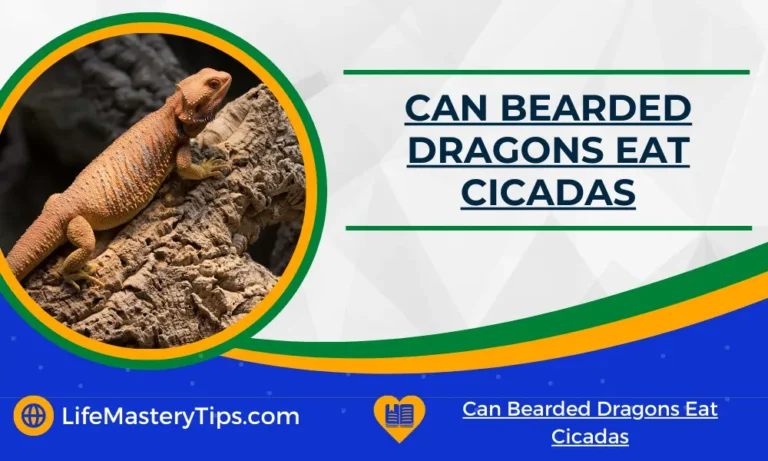Can Bearded Dragons Eat Cicadas? Bearded dragons love to eat cicadas! Cicadas are a great source of protein for bearded dragons and they’re easy to find. All you have to do is go outside and listen for the sound of buzzing cicadas. Once you’ve found them, just pluck them off the tree and give them to your bearded dragon.
Another Interesting Read: Bearded Dragon Whistling Noise
Cicadas, with their resounding hum and unique life cycle, can be an excellent source of nutrition for some reptiles. They are packed with protein, making them a beneficial addition to a bearded dragon’s diet. The protein content aids in muscle development and supports overall growth. Additionally, cicadas offer essential amino acids that contribute to a healthy reptilian lifestyle.
While the nutritional benefits are enticing, it’s crucial to consider the potential risks associated with feeding cicadas to bearded dragons. One concern is the exoskeleton of these insects, which can be quite tough and difficult to digest. If ingested in large quantities, the fibrous exoskeleton may cause gastrointestinal distress or blockages, which can be harmful to your dragon’s well-being.
What bearded dragons can eat
When it comes to the dining preferences of our scaly friends, bearded dragons, it’s no secret that their appetite for various insects is insatiable. They are known to relish a wide array of crawling critters, from crickets to mealworms, and even small roaches. But what about the buzzing delicacy of the insect world—cicadas? Can bearded dragons partake in this seasonal feast with glee?
As the hot summer months roll in, cicadas emerge from their underground slumber and take to the skies in swarms, their vibrant wings fluttering in harmony. These creatures are a favorite treat for many animals, including birds, reptiles, and even humans (yes, humans!). However, before introducing cicadas into your bearded dragon’s diet, it’s essential to delve into the potential implications.
Bearded dragons are omnivorous, meaning that they eat both plants and animals. In the wild, their diet consists of insects, small mammals, and vegetation. In captivity, bearded dragons are usually fed a diet of commercially-available insect food, supplemented with vegetables and fruits.
Some common food items that bearded dragons enjoy include:
#1 – Crickets
Crickets are a common food item for bearded dragons. They should be dusted with calcium powder before being fed to your dragon.
#2 – Mealworms
Mealworms are another common food item for bearded dragons. Like crickets, they should be dusted with calcium powder before being fed to your dragon.
#3 – Vegetables
Bearded dragons enjoy a variety of vegetables, including leafy greens, squash, and sweet potatoes. Vegetables should make up the bulk of your dragon’s diet.
#4 – Fruits
Fruits can be fed as an occasional treat to bearded dragons. Some favorites include mango, papaya, and berries.
#5 – Pinkie mice
Pinkie mice are live prey that can be fed to bearded dragons. This should only be done if you are experienced in handling and caring for pinkie mice.
#6 – Reptile vitamin and mineral supplement
A reptile vitamin and mineral supplement should be added to your dragon’s food occasionally to ensure that they are getting all the nutrients they need.
When feeding bearded dragons, it is important to remember that they are carnivores. This means that their diet should consist mostly of animal protein, with only a small amount of plant matter.
What are cicadas & Can Bearded Dragons Eat Cicadas?
Cicadas are a type of insect that is related to the leafhopper and typically has large eyes, long antennae, and clear wings. There are over 3,000 species of cicada around the world, and they can be found on every continent except for Antarctica.
Cicadas typically live in trees and feed on plant sap. Some species of cicadas can make a loud buzzing noise by rubbing their abdomens against their wings. Cicadas are often considered to be pests because they can damage crops or annoy people with their noise.
Different Types Of cicadas
There are many different types of cicadas, and they come in a variety of colors and sizes.
#1 – Magicicada
The Magicicada is a type of cicada that is found in North America. There are three different species of Magicicada, and they are all red and black. The Magicicada lives underground for 13 or 17 years before emerging to mate. After mating, the female will lay her eggs on tree branches, and the cycle will start over again.
#2 – Tibicen
The Tibicen is a type of cicada that is found in Asia. There are many different species of Tibicen, and they come in a variety of colors including green, brown, and black. The Tibicen typically only lives for two to five weeks after emerging from its underground cocoon.
During this time, the Tibicen will mate and lay its eggs on tree branches. After the eggs hatch, the cycle will start over again.
#3 – Cyclochila australasiae
The Cyclochila australasiae is a type of cicada that is found in Australia. It is one of the largest species of cicada, and it can grow to be up to 2.5 inches (6.35 cm) long. The Cyclochila australasiae has a green body with brown stripes. This cicada typically only lives for six weeks after emerging from its underground cocoon.
During this time, the Cyclochila australasiae will mate and lay its eggs on tree branches. After the eggs hatch, the cycle will start over again.
How Do Cicadas Make Their Noise?
Cicadas make their noise by rubbing their abdomens against their wings. This creates a vibration that can be heard by other cicadas. Male cicadas will often sing to attract a mate. Some species of cicada can be quite loud, and their noise has been known to reach up to 100 decibels.
This is about as loud as a chainsaw or a jackhammer. Cicadas are one of the noisiest insects in the world!
Do Cicadas Bite?
Cicadas do not bite humans, and they are not considered to be dangerous. However, some species of cicada can damage crops or annoy people with their noise. If you are bothered by cicadas, you can try to get rid of them by using a vacuum cleaner or an insecticide.
How Long Do Cicadas Live?
The lifespan of a cicada depends on the species. Some species of cicada live for two to five weeks, while others can live for 13 or 17 years. After a cicada emerges from its underground cocoon, it will mate and lay eggs. Once the eggs hatch, the cycle will start over again.
How to find cicadas
As you might have noticed, cicadas are everywhere. Chances are, if you’ve been outside recently, you’ve seen one (or two, or three…) flying around. But what exactly are these insects, and why are there so many of them?
Cicadas are a type of winged insect
Cicadas are a type of winged insect that belongs to the order Hemiptera. This group also includes bugs and aphids. There are about 3,000 different species of cicada worldwide, and about 150 of those can be found in the United States.
Cicadas Structure
Cicadas typically have large eyes, clear wings, and long antennae. They range in size from about 1/2 inch to 2 inches long. The largest species is the Megapomponia imperatoria, which can grow up to 4 inches long!
Cicadas are often called “locusts,” but this is actually a misnomer. Cicadas are not related to locusts, which are a type of grasshopper. Locusts are also much more destructive than cicadas; while cicadas feed on tree sap, locusts can strip a whole field of vegetation in just a few hours.
How to catch cicadas
Cicadas are flying insects that are related to aphids and other sap-sucking pests. They vary in size, but most cicadas are about 1 to 2 inches long. Cicadas can be found in many different colors, including black, brown, green, and red. Some species of cicadas also have patterns on their wings.
Cicadas spend most of their lives underground as nymphs, feeding on the roots of plants. After several years, they emerge as adults and mate. Females lay their eggs in tree branches, and when the eggs hatch, the nymphs drop to the ground and burrow into the soil to begin their next stage of life.
Conclusion – Can Bearded Dragons Eat Cicadas
Now that you know how to find cicadas and how to feed them to your bearded dragon, you can be assured that your pet is getting the best possible diet. Remember to always supervise your bearded dragon when feeding them cicadas to ensure they don’t eat any bugs that may be harmful. Have fun observing your beardie as it munches away on these nutritious insects!
You Might Also Like:




